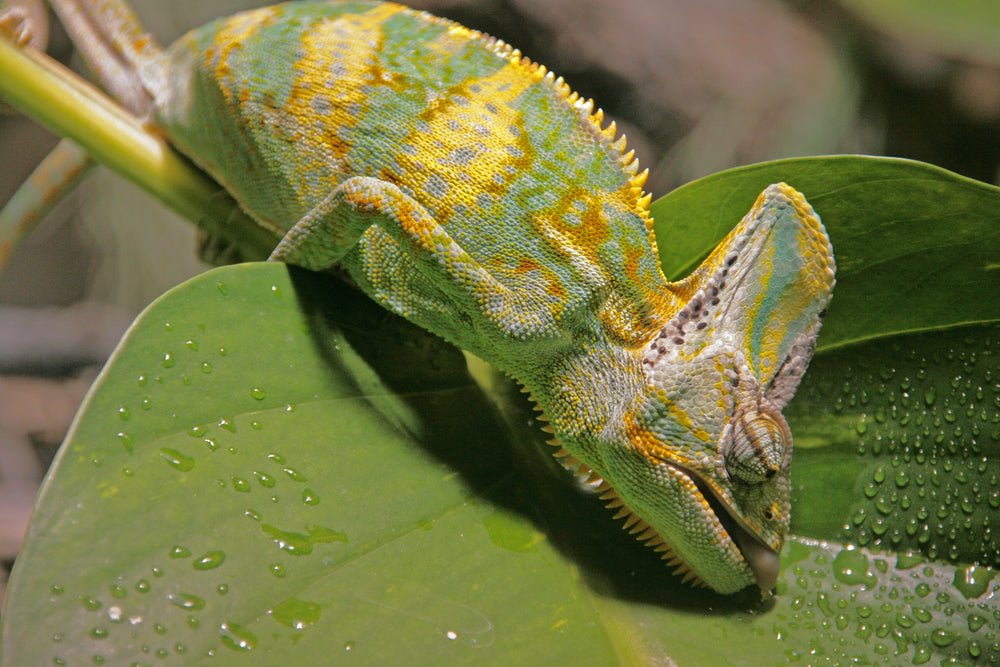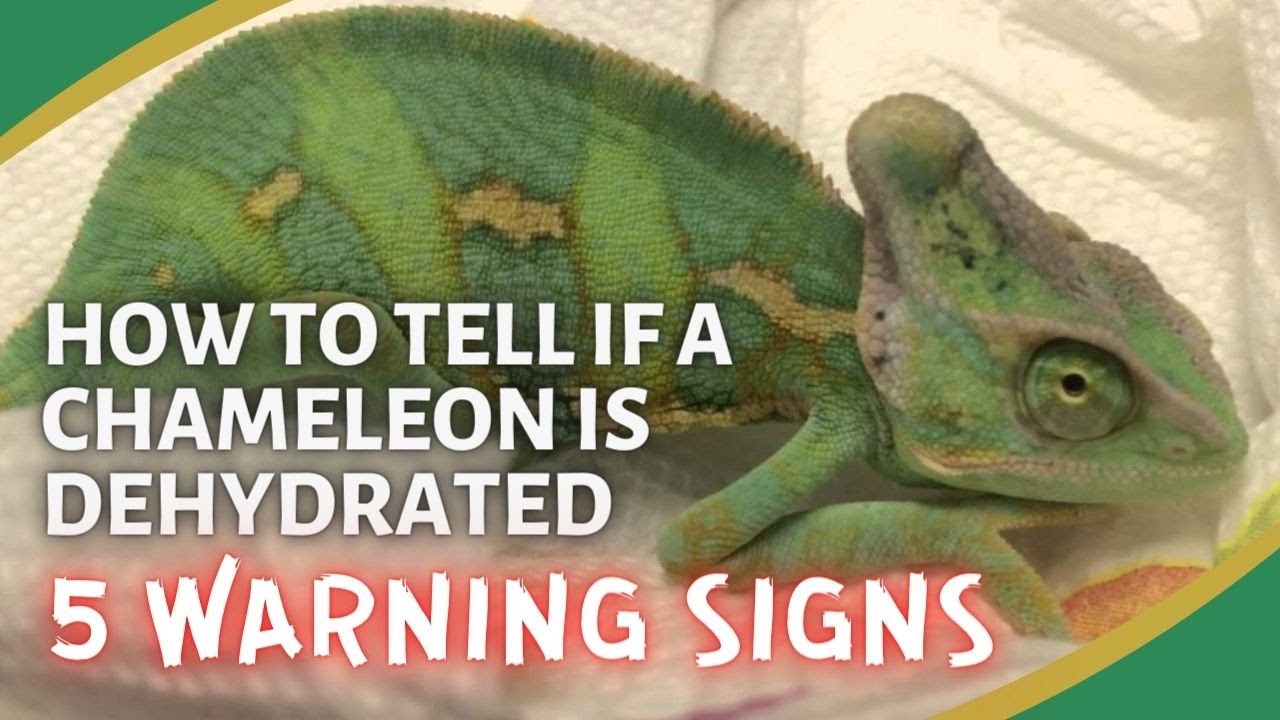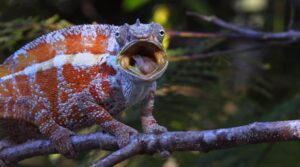A dehydrated chameleon often appears lethargic and its skin may look dull and wrinkled. Its eyes might be sunken or closed.
Understanding the signs of dehydration in chameleons is crucial for their health and well-being. These fascinating reptiles rely heavily on proper hydration to maintain their bodily functions, including skin shedding and color change. As pets, chameleons require attentive care that mimics their natural habitat, which includes access to adequate water sources.
Dehydration can occur quickly in captive chameleons if their environment does not meet their needs. Noticing early signs of dehydration helps prevent more serious health issues. By creating a suitable environment and monitoring your chameleon’s water intake, you can ensure your colorful companion thrives. It is important to recognize these symptoms early to ensure your chameleon stays hydrated and healthy.
Signs Of Dehydration In Chameleons
Chameleons need water just like we do. They live in trees and get their water from the leaves. Sometimes, they get sick and don’t drink enough water. This can make them very dry, or dehydrated. It’s important to know how a dry chameleon looks so we can help them feel better.
Visible Skin Changes
When a chameleon doesn’t have enough water, its skin looks different. The skin may seem dull and less colorful. It can also get very dry and start to wrinkle. This is a clear sign that the chameleon needs water fast.
- Smooth skin turns rough
- Colorful skin gets dull
- Wrinkles appear
Eyes Sinking Into The Skull
A chameleon’s eyes are big and bulge out. If they look sunken, it needs water. The eyes can go deep into the head when there’s not enough water. This is a serious sign of being dry.
| NORMAL | DEHYDRATED |
|---|---|
| Bulging eyes | Sunken eyes |
Always check your chameleon’s skin and eyes. If the skin is wrinkly or the eyes are sunken, give water right away. This will help your chameleon stay happy and healthy.

Credit: emeraid.com
Chameleon Hydration Needs
Chameleons depend on water just as much as any other living creature. Observing these remarkable reptiles in their natural habitat reveals their unique drinking habits. They lap up dew from leaves or absorb moisture from the humid air. In captivity, owners must replicate these conditions to keep their pets hydrated and healthy. Let’s explore how much water a chameleon really needs and how often it should be provided.
Amount Of Water Required
Chameleons need a steady supply of water. Unlike other pets, chameleons don’t drink from a water bowl. They prefer water that mimics rainfall or morning dew. This means providing a daily misting or a drip system that they can drink from as needed.
| Type of Chameleon | Water Quantity |
|---|---|
| Small Species | ~50 ml per day |
| Medium Species | ~100 ml per day |
| Large Species | ~150-200 ml per day |
Frequency Of Water Intake
Chameleons don’t maintain a schedule for water intake. They drink when thirsty. It’s crucial to make water available throughout the day. Considerations include:
- Constant access to dripping or misting water.
- Avoiding water oversaturation; excess can cause issues.
- Monitoring the humidity levels of the enclosure.
In essence, chameleons should be able to hydrate on their own terms. This approach mirrors their natural behavior and promotes optimum health and hydration.
Factors Leading To Dehydration
A dehydrated chameleon shows clear signs of distress. Recognizing these signs involves understanding the factors that lead to this condition. Dehydration can severely impact a chameleon’s health. Let’s explore the main culprits behind a chameleon’s dehydration.
Inadequate Enclosure Humidity
Chameleons thrive in environments with correct humidity levels. Without this, dehydration sets in rapidly. Maintaining these levels is critical for their well-being. Below are key aspects to consider:
- Regular monitoring of humidity inside the enclosure
- Using humidity gauges for accurate readings
- Installation of humidifiers or misting systems if needed
Insufficient Water Supply
Providing a steady water source is vital for chameleons. They often refuse stagnant water, favoring droplets on leaves. To ensure they stay hydrated:
- Misting the enclosure frequently to simulate rain
- Setting up a drip system for continuous water drops
- Offering fresh water daily to promote drinking

Credit: www.thebiodude.com
Physical Appearance Of A Dehydrated Chameleon
Chameleons are remarkable creatures, well-known for their ability to change colors. Good hydration is vital for their health. But what happens when a chameleon is dehydrated? Dehydration affects their physical appearance in several ways. Let’s explore these changes in more detail.
Skin Texture And Elasticity
The skin of a chameleon is a telltale sign of hydration levels. Normally, it should look smooth and supple. A dehydrated chameleon’s skin appears rough and wrinkled. It lacks elasticity.
- Gently pinch the skin.
- If it does not snap back quickly, dehydration is likely.
- Skin may feel sticky or tacky to the touch.
Color And Pattern Changes
Chameleons are famous for their vibrant colors. This can change with hydration levels. Signs of dehydration include:
- Colors become duller.
- Patterns may appear less distinct.
- Overall look is darkened or muddied.
These changes are a chameleon’s way of signaling distress. Immediate care can often reverse these symptoms. It’s crucial for chameleon owners to recognize and address dehydration.
Behavioral Changes In Dehydrated Chameleons
Dehydrated chameleons may not wave or change colors. They act differently, too. Knowing these signs helps keep them healthy.
Reduced Activity Levels
A lively chameleon suddenly becomes sluggish; this is a clue. It may skip its regular climb. It may stay still for long periods. Its grip may weaken. This change indicates possible dehydration.
Change In Eating Habits
A chameleon not eating is worrisome. A hydrated one catches bugs with quick tongue shots. Dehydration slows this reflex. It makes them ignore food. They might drop food from their mouth. Weight loss may follow.
- Watch for tongue and eating speed.
- Note any dropped or ignored food.
- Monitor their weight closely.
Health Implications Of Dehydration
Health Implications of Dehydration in chameleons are serious and can affect their well-being in multiple ways. Recognizing dehydration in these creatures is crucial since they might not show obvious signs until they’re severely affected. Side effects of dehydration involve a range of complications, from mild discomfort to life-threatening conditions.
Potential For Organ Failure
Dehydration can lead to critical organ failure in chameleons. Without adequate water, their bodies cannot function properly. Kidneys are especially at risk. They need water to filter out toxins from the blood. A dehydrated chameleon might experience kidney failure, which can be fatal.
- Blood becomes more concentrated, making it harder for organs to work.
- Toxins build up as kidneys cannot filter them out.
- Organ tissues need hydration to stay healthy; without it, they suffer damage.
Impaired Physiological Functions
Dehydration impacts many physiological processes in chameleons. Vital functions slow down or stop without enough water.
- Hydration is crucial for proper blood flow; lack of water impedes it.
- Muscle movements require fluid; dehydration leads to weakness and lethargy.
- Metabolic processes slow down, hindering growth and healing.
Providing Proper Hydration
Chameleons are remarkable creatures, showcasing vibrant colors and acrobatic tongues. But to maintain their health and diverse displays, they require proper hydration. A dehydrated chameleon may show sunken eyes, lackluster skin, and reduced elasticity. Ensuring they receive adequate water is vital. The following sections outline effective methods to keep your chameleon hydrated, mirroring their natural habitat.
Effective Misting Practices
Misting creates a rainforest-like environment, which chameleons adore. Using a fine spray bottle or automatic mister, lightly coat the leaves and branches in your chameleon’s enclosure. Aim for two to three times daily, keeping sessions to less than a minute to mimic natural rainfall. Remember, gentle droplets allow chameleons to drink without being overwhelmed.
- Early morning and late evening are prime misting times.
- Mist should fully evaporate between sessions to prevent mold.
Drip Systems And Water Features
Chameleons don’t recognize still water as a drinking source. Drip systems or water features encourage hydration through movement. A dripping leaf or a small waterfall within their habitat entices them to take a sip.
| Drip System | Water Feature |
|---|---|
| Directs water onto leaves | Provides flowing water |
| Adjustable drip rate | Visually stimulating |
| Easy to refill | Requires filtration |
Both options need regular cleaning to prevent bacteria and keep your chameleon healthy. Ensure water drips slowly and steadily, making the environment comfortable. A hydrated chameleon is a happy and healthy one.
Recovery And Rehabilitation
When a chameleon shows signs of dehydration, quick action is crucial. The path to recovery involves careful monitoring and precise methods to rehydrate the reptile. These steps encourage healing and help restore the chameleon’s health and vitality.
Rehydrating Effectively
A dehydrated chameleon needs fluids to recover. Start with lukewarm showers or a drip system for gradual water intake. Use a clean spray bottle to mist your chameleon regularly. Offer water-rich foods, like worms and fruits, for extra hydration. Adopt these methods to rehydrate your pet:
- Mist habitat twice a day to maintain humidity.
- Provide shallow water dishes for easy access.
- Administer electrolyte solutions if recommended by a vet.
Monitoring For Improvement
Consistent checks on your chameleon’s condition are essential. Look for clear eyes, regular eating, and active behavior as signs of progress. Keep track of the humidity and temperature daily. Use this monitoring table as a guide:
| Signs of Recovery | Frequency of Monitoring | Notes |
|---|---|---|
| Hydration levels | Daily | Check skin elasticity and eye bulge. |
| Appetite | Every meal | Monitor the type and amount of food consumed. |
| Activity levels | Twice a day | Assess alertness and strength during handling. |
Preventing Future Dehydration
To keep your chameleon vibrant and active, preventing dehydration is critical. A dehydrated chameleon may showcase sunken eyes, lack of skin elasticity, and lethargy, which are clear distress signals. Engagement in proactive measures will maintain your chameleon’s hydration, ensuring its well-being and longevity. Let’s explore how to create a sustainable environment that keeps dehydration at bay.
Regular Maintenance Of Habitat
Creating an ideal living space is vital for your chameleon’s health. Here are key steps:
- Monitor humidity levels to ensure they stay within the recommended range.
- Hydration stations such as misters can automate the process.
- Clean water sources should be available and refreshed daily.
Keeping a consistent routine prevents dehydration and promotes a thriving environment for your chameleon.
Importance Of Regular Health Checks
Consistent health checks are crucial for early detection of dehydration.
- Visual inspections should be part of your daily care routine.
- Monitoring your chameleon for signs of stress or illness can guide your care decisions.
- Veterinary checks should be scheduled periodically for professional assessment.
These measures ensure swift action before serious issues take hold, safeguarding your chameleon’s health.
Understanding Chameleon Behavior
Understanding Chameleon Behavior: To ensure the health of a chameleon, close observation is key. Every pet owner should recognize the difference between normal chameleon activities and signs of distress. By understanding their typical behaviors and knowing what to look for, you can quickly spot if something is amiss, such as dehydration.
Recognizing Normal Versus Abnormal Behavior
A healthy chameleon displays a range of normal behaviors that indicate well-being. These include active hunting, steady movements, proper gripping of branches, and vibrant skin coloration. Conversely, abnormal behavior might signal an underlying health issue.
- Decreased activity levels
- Weak grip on their perches
- Dull or dark coloration
- Less food intake
Stress Signals And Warning Signs
Stress in chameleons often leads to more serious health problems. Stress indicators include:
| Behavior | What it might signal |
|---|---|
| Sunken eyes | Possible dehydration or illness |
| Prolonged hiding | Stress or discomfort |
| Gaping mouth | Thermal stress |
| Shaking or twitching | Calcium deficiency or distress |
Instant responses to these warning signs are crucial for a chameleon’s well-being. Veterinarian advice is essential if any of these behaviors persist.
Credit: www.chameleonforums.com
Frequently Asked Questions For What Does A Dehydrated Chameleon Look Like
What Are Signs Of A Dehydrated Chameleon?
A dehydrated chameleon may exhibit sunken eyes and dry skin. Its skin might appear less vibrant and more wrinkled than usual. The chameleon can also become lethargic and show a decreased appetite. Pay attention to these symptoms for its health.
How Can You Hydrate A Chameleon Quickly?
To quickly hydrate a chameleon, gently mist it and its habitat with water. Providing a dripping system can also encourage drinking. Always ensure fresh water is available. Consult a vet if dehydration signs persist, as it could indicate health issues.
What Causes Dehydration In Chameleons?
Dehydration in chameleons can result from inadequate humidity levels, insufficient water intake, or overheating. It’s important to monitor their environment and offer proper hydration options. Chameleons typically prefer licking droplets off leaves rather than drinking from a bowl.
Can Dehydration Affect A Chameleon’s Coloration?
Yes, dehydration may dull a chameleon’s coloration. Healthy hydration supports vibrant color displays. If a chameleon’s skin seems faded or less colorful, it might need more moisture, either through direct drinking or higher humidity in its habitat.
Conclusion
Understanding the signs of dehydration in chameleons is crucial for their welfare. Sunken eyes, dull skin, and decreased activity are warning signals. Regular misting and proper hydration care are essential. Stay vigilant for a happy, healthy chameleon companion. Prioritize their hydration needs to ensure vibrancy and vitality in these remarkable reptiles.


